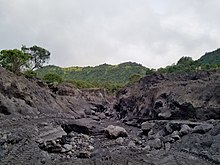Altitude level (geomorphology)
As geomorphology height levels exclusively in are high mountains similar areas occurring surface shapes referred to, which lie in a vertical sequence on each other. They are caused by abiotic-physical processes in a pronounced mountain climate and are described by looking at the soil . The height limits depend on the specific conditions; the processes and the characteristics of the levels are comparable worldwide.
In general, the zonal classification of mountains is based primarily on natural vegetation and is described in ( landscape-ecological ) vegetation height levels . Above the tree line , however, the shaping influence of living beings ( biochemical soil formation , rooting , activities of animals, etc.) decreases and is determined more and more by climatic-physical factors (temperature change, precipitation, ice, wind) towards the summit . In this respect, the altitude levels above the tree line are geomorphologically relevant.
There are basically three (or four) altitude levels, the transitions of which are mostly fluid and the limits of which can shift over time due to climate changes (such as the current global warming ).
"Real" geomorphological levels
The following three height levels are fully pronounced in humid regions. In arid mountains they can only be present to a limited extent or not at all, since the decisive factors water and ice are largely absent.
Glacial elevation

The glacial or glacier level is (apart from the special "insolation level" ) the top level, which is determined according to the existing or recent glaciation. It is characterized by spatially very large shapes and the relief of the completely covering glaciers. The valley shape of the Kare is considered to be its main shape . In addition, the relief is characterized by forms of prehistoric glacial erosion (round humps, troughs, trough shoulders, etc.).
Nivale altitude level
The nivale or frost rubble level spreads from the glacier edges down to the climatic snow line . There, patches of snow and forms of erosion through snow with terracing next to the frost debris pile form the dominant landscape elements . In contrast to the deeper periglacial altitudinal zone, the landscape is more divided and there is a tendency to sharpening of the suspension by Nivationsprozesse and Runsenbildung .
The highest vegetation level in the mountains is also referred to as the nival altitude level. However, it also includes the glacier level at the top and is not limited at the bottom by the presence of geomorphological phenomena, but by the lack of certain plant formations or species . In this respect, the level limits can also be different for the same mountain range, depending on how you look at it! The term subnival is also an ecology term.
Periglacial elevation

The periglacial or solifluction level is the lowest, dominant geomorphologically shaped altitude level. It is characterized by a gentle, rounded, balanced relief that is created by soil flowing over permafrost soils ( solifluction ). Processes of frost-related weathering - e.g. visible as frost pattern soils - and soil erosion determine the shape. Since a strong root penetration significantly reduces these processes, the periglacial zone extends from the snow line down to the border of the mountain forest . Their expression is often differentiated over a small area depending on the rock. Block heaps can be observed in the foot area of steep slopes .
In terms of vegetation ecology, the solifluction stage begins in the subalpine zone, takes up the entire alpine zone and extends into the subnival zone.
"Insolation level"
Without a clear designation, a further, fourth geomorphological height level is shown for the summit regions of the eight-thousanders in the Karakoram and Himalayas as well as the Vinson massif in the Antarctic. There is only direct weathering due to extremely fluctuating temperatures between −10 ° and −40 ° C every day. At these temperatures, glacial processes (conversion of snow to ice, thawing) are no longer possible.
Elevation levels below the tree line

From the lowlands to the tree line, biogenic factors dominate . Geomorphologically, “only” fluvial (caused by flowing water) or volcanic influences are relevant there, so that the entire area is not further subdivided geomorphologically. There is no uniform naming. If necessary, statements on this are gladly adopted from the ecologically defined altitude levels.
literature
- Alexander Stahr , Thomas Hartmann: Landscapes and landscape elements in the high mountains , Springer, Berlin / Heidelberg 1999, ISBN 978-3-540-65278-6 .
- Conradin Burga , Frank Klötzli and Georg Grabherr (eds.): Mountains of the earth - landscape, climate, flora. Ulmer, Stuttgart 2004, ISBN 3-8001-4165-5 .
Individual evidence
- ↑ a b c d e Alexander Stahr , Thomas Hartmann: Landscapes and landscape elements in the high mountains , Springer, Berlin / Heidelberg 1999, ISBN 978-3-540-65278-6 , pp. 20-23.
- ↑ Werner Bätzing : Small Alpine Lexicon. Environment - economy - culture. CH Beck, Munich 1997, ISBN 3-406-42005-2 , pp. 104-108.
- ^ Frank Lehmkuhl, Jürgen Böhner , Georg Stauch: Geomorphological formation and process regions in Central Asia. In: Petermanns Geographische Mitteilungen . Issue 147, May 2003, pp. 8–9 ( online pdf version , accessed on August 2, 2020).
- ↑ Glossary: periglacial elevation. In: Glossary database. Uni Halle-Wittenberg, August 21, 2009, accessed on August 4, 2020.
- ↑ Keyword: Altitude levels , entry in the online encyclopedia of geography, Spektrum Akademischer Verlag, Heidelberg 2001, accessed on August 8, 2020.
